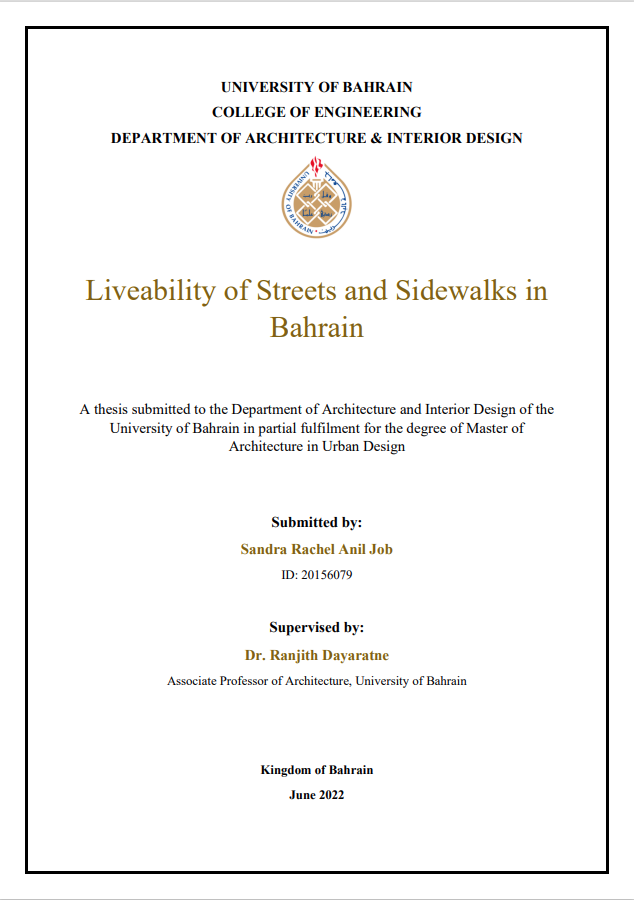Identifier
https://digitalrepository.uob.edu.bh/id/b907f45c-2424-43a9-b770-69d4dc3d59e2
https://digitalrepository.uob.edu.bh/id/b907f45c-2424-43a9-b770-69d4dc3d59e2
Liveability of Streets and Sidewalks in Bahrain
Linked Agent
Dayaratne, Ranjith , Thesis advisor
Language
English
Extent
[1], 462, [58] pages
Subject
Place of institution
Sakhir, Bahrain
Thesis Type
Thesis (Master)
Institution
UNIVERSITY OF BAHRAIN, COLLEGE OF ENGINEERING, DEPARTMENT OF ARCHITECTURE & INTERIOR DESIGN
Description
Abstract:
Liveability is generally assumed as the degree to which a place is suitable for living. However, due to its complexity, this definition varies from one person to another. Good cities are liveable. In a liveable city, one can commute and perform their everyday activities harmoniously There are several principles required to classify a place as “liveable”. Some of these are promoting walkability, enhancing communities, providing transportation, and fostering economic growth and well-being. In terms of the public realm, a city is liveable when its streets are liveable. Well-designed streets and sidewalks can enhance the liveability of the area. A “liveable street” is a concept that focuses primarily on people: pedestrians and cyclists. It also implies that streets, along with nearby neighbourhoods are safe and comfortable to live in. This is a common issue that relates to all cities. However, cities in different parts of the world may have specific issues that emanate from their unique circumstances.
In Bahrain, there exist several issues related to pedestrian safety where mobility within the city is in support of vehicles, resulting in alarming fatalities of pedestrians. Moreover, in the historic city centres where traditional narrow streets exist, the absence of vehicle restrictions results in congestion and inconvenience. Moreover, the lack of proper sidewalks and crosswalks also causes a safety hazard to pedestrians and cyclists. Improper usage of pedestrian crossings and overspeeding of vehicles has also led to fatalities and accidents on pedestrian crossings on highways. Urban design aims to promote walkable, high-quality public realms. Therefore, the liveability of a street is directly linked to urban design and through successful urban design and planning, a place can be made liveable.
Liveability is generally assumed as the degree to which a place is suitable for living. However, due to its complexity, this definition varies from one person to another. Good cities are liveable. In a liveable city, one can commute and perform their everyday activities harmoniously There are several principles required to classify a place as “liveable”. Some of these are promoting walkability, enhancing communities, providing transportation, and fostering economic growth and well-being. In terms of the public realm, a city is liveable when its streets are liveable. Well-designed streets and sidewalks can enhance the liveability of the area. A “liveable street” is a concept that focuses primarily on people: pedestrians and cyclists. It also implies that streets, along with nearby neighbourhoods are safe and comfortable to live in. This is a common issue that relates to all cities. However, cities in different parts of the world may have specific issues that emanate from their unique circumstances.
In Bahrain, there exist several issues related to pedestrian safety where mobility within the city is in support of vehicles, resulting in alarming fatalities of pedestrians. Moreover, in the historic city centres where traditional narrow streets exist, the absence of vehicle restrictions results in congestion and inconvenience. Moreover, the lack of proper sidewalks and crosswalks also causes a safety hazard to pedestrians and cyclists. Improper usage of pedestrian crossings and overspeeding of vehicles has also led to fatalities and accidents on pedestrian crossings on highways. Urban design aims to promote walkable, high-quality public realms. Therefore, the liveability of a street is directly linked to urban design and through successful urban design and planning, a place can be made liveable.
Member of
Category
Theses


